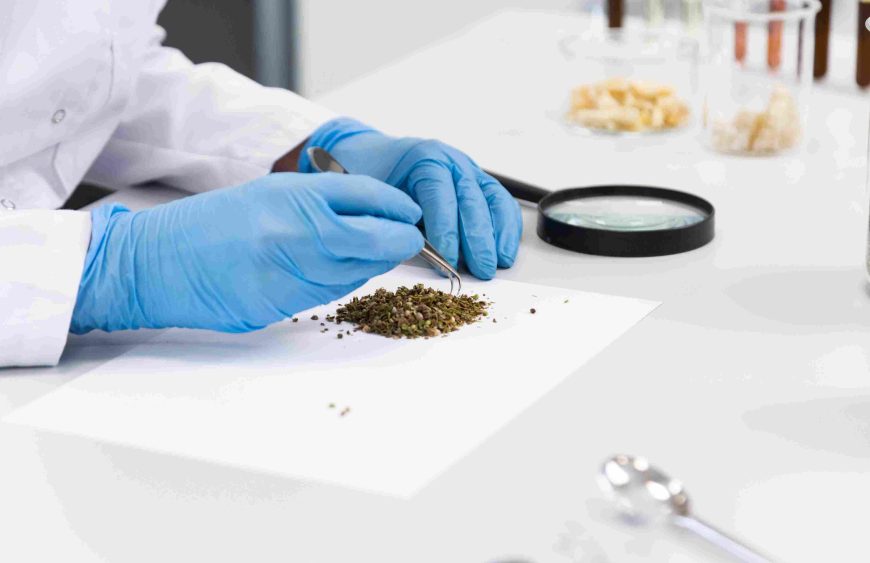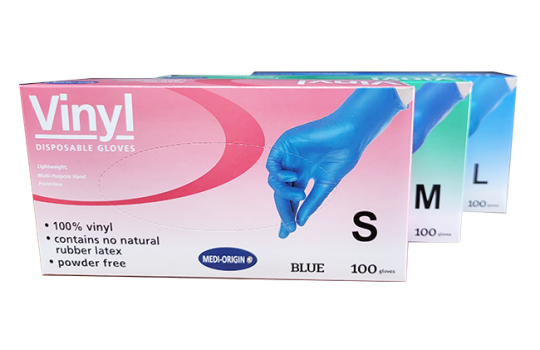What Protections Can Nitrile Disposable Gloves Provide?
January 30, 2023 2023-01-30 2:27What Protections Can Nitrile Disposable Gloves Provide?

What Protections Can Nitrile Disposable Gloves Provide?
Personal protection equipment (PPE) like disposable gloves is crucial, thus picking the best disposable glove for your business should always be a high priority.
In particular, healthcare personnel require trustworthy disposable gloves that will protect them from potential dangers like chemicals, biological materials, sharp objects, and more. Because they are protective, long-lasting, simple to replace, inexpensive, and latex-free, nitrile gloves are a practical choice for the healthcare sector.
This article will explain what nitrile gloves are, what they are used for, what risks they do and do not protect against, and how to pick the best disposable glove for your application in order to help you make an informed PPE decision.
How Can We Define Nitrile Gloves?
Workers in a variety of industries can safeguard their hands with disposable, cost-efficient nitrile gloves. The abbreviation for acrylonitrile-butadiene rubber is nitrile. Nitrile rubber gloves are synthetic and free of latex, unlike latex gloves, which are produced using natural rubber. This means that for anyone who has a latex allergy, nitrile gloves are a dependable PPE choice.
The rubber from rubber trees must first be converted into latex rubber before being further processed to create these synthetic rubber gloves. The monomers acrylonitrile and butadiene are joined to generate the nitrile compound substance after the rubber has been processed to create latex. Nitrile gloves are reliably free of latex thanks to this additional processing step that eliminates all latex proteins.
The resulting nitrile gloves are strong and chemical and puncture resistant. Disposable nitrile rubber glove production used to be an expensive operation, but recent technological improvements have made it more affordable. Gloves made of nitrile are now priced on par with latex gloves. Nitrile gloves are frequently preferred over latex gloves due to their accessibility, affordability, and low allergy rating.
Nitrile rubber gloves are excellent for a wide range of applications since they come in a number of colours, thicknesses, and sizes. Additionally, because nitrile gloves are ambidextrous and unisex, there is no need for employers to worry about maintaining a variety of types in stock and workers can save time by not having to search for matching sets.
What Are the Purposes of Nitrile Gloves?
PPE nitrile gloves are appropriate for use in a range of industries. The disposable gloves offer reliable hand defence against a variety of potential dangers, such as wounds, liquids, and abrasive materials.
Nitrile gloves are a useful asset for businesses that need prolonged PPE use due to their pleasant fit and simplicity of application and removal. Additionally, if the task or application calls for frequent glove changes over a short period of time, nitrile gloves are appropriate.
Nitrile gloves, in particular, can help employees in these situations:
- Medical facilities: When a medical professional is examining a patient, handling biological materials, or disposing of medical waste, nitrile gloves are frequently utilized because they provide a two-way contact barrier.
Nitrile gloves provide healthcare personnel in a range of specialities with dependable hand protection during examinations, surgery, dentistry, and medicines. To guarantee proper safety, staff members in hospitals and other healthcare facilities are recommended to use nitrile gloves.
- Chemical labs: People who operate in laboratories on a regular basis frequently come into contact with potentially dangerous compounds. Nitrile gloves are a practical option for shielding these personnel from hazardous substances like toxic chemicals and organic solvents due to their chemical resilience.
- Industrial facilities: Nitrile gloves are ideal for use in industrial and commercial environments since they can protect users from dangers such as commercial cleaning solutions, chemicals, pesticides, and more. Nitrile gloves are also used by those in manufacturing, the automotive industry, and janitorial work because of their flexibility.
- Foodservice: Nitrile gloves can provide the wearer with additional protection while preparing meals and are safe to use when handling food. Nitrile gloves are simple to change, which makes them ideal for employees who frequently need to change their gloves in customer-facing positions. Additionally, a food-based business can prevent cross-contamination by adopting a color-coded system of nitrile gloves.
Why pick synthetic rubber over natural rubber when wearing gloves?
Natural latex rubber gloves cannot provide a number of advantages that nitrile gloves can. The top five benefits of selecting nitrile rubber gloves over latex gloves are listed below.
- High puncture resistance: Nitrile gloves are more durable than latex gloves because of their resistance to tears and punctures. A hole in a pair of disposable rubber gloves could expose the wearer to hazardous environmental toxins, hence puncture resistance is crucial for PPE.
- Greater chemical resistance: Nitrile gloves are more chemically resistant than latex gloves, in addition to being more puncture-resistant. By acting as a robust barrier of protection, nitrile gloves can help keep the wearer safe from chemicals, acids, and oils.
- Latex-free: Nitrile glove, unlike natural rubber gloves, are acceptable for anyone with sensitive skin or a latex allergy. In medical environments where healthcare practitioners must be mindful of individuals who might have a latex allergy, latex-free gloves are especially preferred.
To prevent unintentionally triggering an allergic reaction in a patient, healthcare staff should only wear hypoallergenic gloves.
- More snug and pleasant fit: Nitrile rubber adapts better to the contour of the human hand when body heat heats the gloves, providing a more secure and cozy fit than latex gloves. The wearer benefits from improved dexterity to perform activities quickly and comfort to wear the gloves for a longer period of time thanks to the more natural fit.
- Less difficult to put on and take off than natural rubber latex gloves: Nitrile rubber gloves have a lower friction resistance than natural rubber latex gloves. Finishes are added throughout the nitrile glove manufacturing process to facilitate putting on and taking off the disposable gloves.
Because of this finish, nitrile gloves can be put on without the need for powder, reducing the possibility of leaving behind powdery residue.
Are nitrile gloves resistant to chemicals?
Because it resists chemical deterioration and short-term splash resistance against a variety of chemicals, synthetic nitrile rubber is a dependable material for general-purpose gloves. Additionally, nitrile gloves give users a long breakthrough time, which is the amount of time that passes between the initial chemical contact on the glove surface and the chemical becoming detected on the inside of the glove.
Nitrile gloves can offer protection from a wide range of chemicals, but they are not impervious to all agents. Before purchasing nitrile gloves, be sure they are acceptable for the materials you expect to use them on.
Most significantly, nitrile gloves offer sufficient defence against several typical chemicals:
- Acetone
- Ethanol
- Isobutyl
- Isopropyl
- Methanol
Nitrile gloves: Are they impermeable?
Whatever the lifespan of a single-use rubber glove, nothing is ever completely impervious. Nitrile gloves eventually allow some substances to slip through. However, nitrile gloves have a better permeability rate than many other types of rubber gloves, such as latex gloves.
A permeation resistance test, in general, gauges how quickly various compounds may diffuse through a substance at the molecular level. The rate at which a chemical can permeate a glove’s material by absorbing into the glove’s surface, diffusing through the material, and desorbing onto the glove’s inner surface is referred to as the permeation rate.
Since nitrile gloves have a lower absorption rate than latex gloves and can withstand chemicals for a longer time, they provide more protection. A wearer of nitrile gloves is given a little extra time by a higher permeation rate to safely switch their gloves after coming into contact with a dangerous substance.
What Are the Protections of Nitrile Gloves?
Wearing the proper glove helps protect employees’ hands from burns, infections, wounds, and abrasions. Wearers of nitrile gloves can prevent their hands from coming into contact with a variety of dangerous and abrasive substances. Nitrile gloves can safeguard any fragile objects being handled, like electronics, metal, and glass, in addition to protecting the wearer.
Before going into detail about the specific compounds that nitrile gloves defend against, it’s crucial to understand the difference between incidental contact and extended contact. To distinguish between incidental and extended contact scenarios, use the following definitions:
- Incidental contact: Situations involving minor contact with hazardous materials, such as unintentional overspray from a dispensing machine, accidental splashes or spills, and dealing with infectious agents that call for barrier protection. In these circumstances, all that is required to prevent accidental contact is a barrier between the glove user and the substance.
- Extended contact: Situations that call for longer-lasting exposure, like coming into contact with highly contaminated materials, dipping hands into chemicals or other potentially harmful substances, dealing with extremely high or low temperatures, or handling sharp or piercing things.
The precise level of protection a nitrile glove can offer against a substance relies on the thickness of the glove. Thinner nitrile gloves, like disposable exam gloves, are designed for brief contact; in contrast, thicker nitrile gloves, such bulkier reusable gloves, are ideal for prolonged contact.
In general, disposable nitrile gloves with a thickness of at least 5 millimetres can prevent breakthroughs after contact with a variety of chemicals for 15 minutes.
What Are Nitrile Gloves Not Suitable For?
Nitrile gloves are suitable for handling a wide range of chemicals and hazardous materials, however there are some serious substances that they shouldn’t be used with.
Nitrile gloves have a weak resistance and a breakthrough time of less than a minute when exposed to severely dangerous compounds. The wearer’s hand could sustain skin harm if the hazardous substance penetrates the glove.
How to Get Rid of Nitrile Gloves That Have Been Contaminated
Cross-contamination can be avoided by employing the proper glove disposal technique.
When your gloves are infected, do the following actions:
- Hold one glove by the outside at the wrist, taking care not to touch your flesh.
- Pull the glove inside out as you peel it away from your body.
- In the gloved hand that is still on the freshly removed glove.
- Start removing the glove by slipping your bare fingers inside the top of the one you’re still wearing.
- As you draw the second glove away from your body, flip it inside out, leaving the first glove inside the second.
- Make sure the gloves are properly disposed of so they are never used again.
- As soon as you take off the contaminated gloves, wash your hands.
What to Look for When Choosing a Disposable Glove?
Determining the dangerous substances you are most likely to come into contact with will help you choose the best disposable glove for your business. You will require a disposable glove that offers appropriate protection against these materials, gives you the comfort and flexibility you need to complete your activity properly, and is reasonably priced.
Identifying the danger you need protection from is the first step in choosing the best disposable glove for you. Think about the following elements:
- Chemical types: Your gloves need to have a higher level of chemical resistance and chemical degradation resistance the more corrosive the chemicals you’re working with are.
- Extreme temperatures: To protect against heat and flame, make sure your gloves do.
- When dealing with physical risks, such as sharps or piercing items: you need gloves that are cut- and puncture-resistant.
- Toxicity: When working with dangerous products, go with gloves that have a low absorption rate.
- The potential for biological materials to transmit disease: To reduce the risk of infection when handling biological materials, wear thicker gloves.
The next step is to decide if you will come into touch with the materials on a short-term or long-term basis. For applications involving accidental contact, disposable surgical-style gloves are ideal.
Since nitrile gloves are more resistant to chemicals and have a reduced propensity to rupture when pierced, they are preferred to latex gloves.





